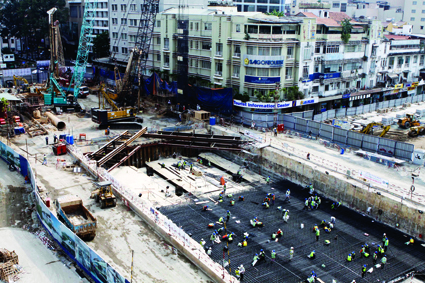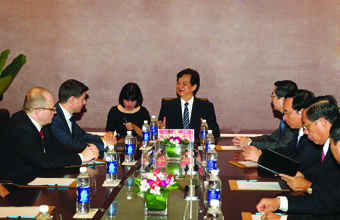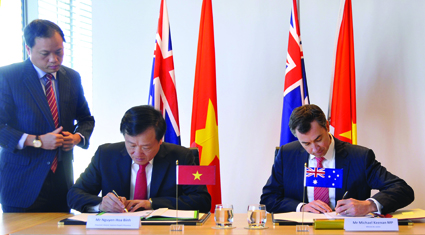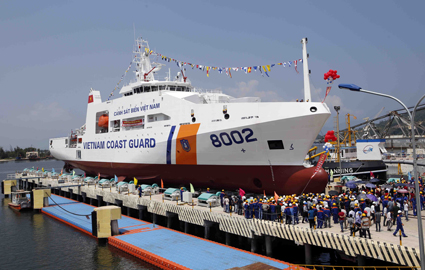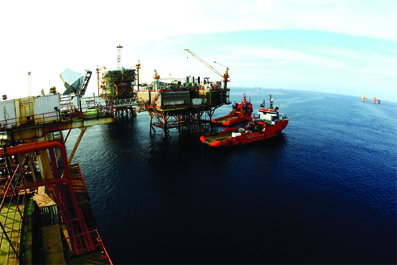Truong-Minh Vu1
With China tightening its grip on much of the South China Sea, the Association of Southeast Asian Nations (ASEAN) is struggling to adopt an appropriate and unified response. Ironically, this year is supposed to be the “Year of China-ASEAN Maritime Cooperation”. Since Cambodia’s disastrous chairmanship of the regional body, which led to tremendous divisions within the ASEAN and acrimonious exchanges between Cambodia and the Philippines, there have been concerted efforts, especially by Indonesia (the informal regional leader), to ensure China doesn’t use its regional pawns to block discussions over the ongoing disputes. The product, however, is a new orthodoxy, whereby ASEAN expresses “serious concerns” vis-à-vis the South China Sea disputes, but repeatedly falls short of offering any tangible response.
China’s accelerated construction activities in the South China Sea have further intensified the ongoing maritime disputes between Beijing and the Philippines and Vietnam. More than just complicating the ongoing disputes at the expense of other claimant states, China’s land reclamation activities signal a growing military assertiveness, as the People’s Liberation Army (PLA) moves toward “peripheral defense” and consolidation of its strategic depth in the area. China’s man-made islands fortify its already expansive presence in the contested areas, fulfilling Beijing’s broader grand strategy of dominating adjacent waters, particularly vital Seal Lines of Communication (SLOCs) in the South China Sea. The ongoing construction activities could very well pave the way for the establishment of a Chinese Air Defense Identification Zone (ADIZ), as Beijing completes a network of airstrips and military garrisons across the Paracels and the Spratlys. These are real implications for freedom of navigation and flight in the area.
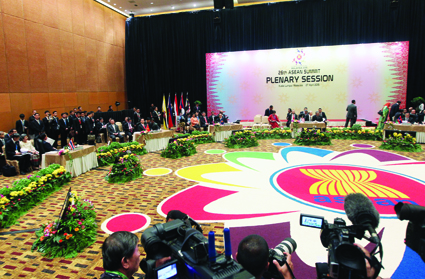 |
The Plenary Session of the 26th ASEAN Summit in Malaysia on April 27, 2015__Photo: Duc Tam/VNA |
There are growing fears, especially in Manila and Hanoi, that China will increasingly interfere with activities of other littoral countries with regard to marine surveillance, research, fishing, hydrocarbon exploration and development in the South China Sea. Most importantly, China’s actions represent a fundamental challenge to the sovereignty claims of neighboring states, undermining their ability to lawfully exercise jurisdiction, in accordance with the United Nations Convention on the Law of the Sea (UNCLOS), within their exclusive economic zones and continental shelf.
A more fundamental problem with ASEAN is the absence of convergence in terms of “threat perceptions” vis-à-vis China. Singapore’s Law Minister K. Shanmugam brilliantly summed up the prevailing state of mind of the majority of ASEAN nations when he bluntly stated: “If you start looking at ASEAN-China relations through the prism of South China Sea, you are getting it wrong completely…The facts on the ground are the very substantial economic, security, political relationship between China and every country in ASEAN and ASEAN as a whole. The South China Sea forms part of it and we will not be doing our duty for our country and our people if we forget that [authors’ emphasis].” In short, the South China Sea disputes don’t and shouldn’t define the overall texture of China-ASEAN relations. It is not worth alienating a key trading partner, so the argument goes, over disputes that are essentially bilateral in nature.
Frustrated by ASEAN’s growing irrelevance, the Philippines and Vietnam have opted for minilateralism, moving toward a strategic partnership vis-à-vis the common Chinese threat in the South China Sea. The relevance of this budding alliance, however, lies in how it serves as a component of a larger informal network of alliances on China’s peripheries, especially as middle powers such as Japan and India augment the U.S.-led efforts at reining in China’s growing assertiveness across the western Pacific.
In contrast, the Philippines and Vietnam view the South China Sea disputes as the defining issue of ASEAN-China relations. For them, what is the whole point of regional integration and solidarity when China can easily divide and conquer its Southeast Asian counterparts? Against the backdrop of ASEAN’s limited utility, Hanoi and Manila have deepened their security ties, culminating in a strategic partnership agreement, which will pave the way for regularized joint naval, coast guard exercises, and scientific research in the South China Sea; institutionalized high-level bilateral dialogue; and greater diplomatic coordination and unison in regional and international fora.
By adopting common positions on the UNCLOS and its significance for the South China Sea, for instance, the two countries have sought to delegitimize China’s sweeping “nine-dash-line” claims in the area. Hanoi and Manila hope that their blossoming partnership will encourage other Southeast Asian claimant states such as Malaysia to eventually tag along. Growing strategic cooperation between the two Southeast Asian countries, however, has been long overdue. Since the end of the Cold War, both Hanoi and Manila have been at the receiving end of China’s expanding claims across the South China Sea. But it is only in recent years that they have seriously explored closer strategic ties, recognizing that if they don’t hang together, they will be hung separately.
Interestingly, it is highly likely that Manila decided to pursue deeper ties with its communist neighbor only after its top ally, the United States, moved to sign up Vietnam as a potential bulwark against Chinese expansionism in Southeast Asia. And perhaps it is only now that the Philippines has realized the importance of diversifying its strategic options by reaching out to as many like-minded countries as possible. Previously, the Philippines not only saw Vietnam as a potential competitor in the Spratly chain of islands, but also questioned the utility of reaching out to a relatively weak neighbor. (Not to mention, Vietnam’s close party-to-party ties with its giant communist neighbor, China, also presented some ideological barriers and raised some suspicion among certain Filipino policy-makers.) As for Vietnam, they see the Philippines as a diplomatically bold Southeast Asian country, which has dared to take China to the court over the South China Sea disputes. Vietnamese strategists are carefully examining whether they can emulate Manila’s legal maneuver to potentially extract territorial concessions from China.
Since 2009, the lack of normative order in the South China Sea has paved the way for legal and academic fireworks. It started with the Department of State of the United States publishing a report (Limits in the Sea) analyzing the legal status of China’s “nine-dash-line” claim just two days before China’s position paper. This 26-page report offered a detailed breakdown of the legality of the nine-dash line, concluding that the legal status of the Chinese U-shape line could be found nowhere in the Law of the Sea Convention. This can be seen as a strong and direct attack to the credibility and legitimacy of China’s claims as well as an argument relevant to the South China Sea disputes. More importantly, the report can also be viewed as a U.S. proposal to ASEAN countries for a “juridical alliance” with respect to the freedom of navigation and dispute settlement in the South China Sea. Given the power discrepancy with China, having the U.S. defend the validity of existing rules and procedures, and their usefulness in dispute management in the South China Sea, is a major asset, especially given that all claimants seek the moral high ground.
Yet the overwhelming priority for ASEAN is resolving its own internal disparities, which have restricted the bloc’s actions against China as well as its ability to engage other major powers in a peaceful South China Sea dispute settlement. The Philippines initiated the arbitration proceedings against China in January 2013. Vietnam also sent its statement of interests to the same arbitral tribunal. But there is still not a strategic cooperation within ASEAN in legal terms. The first target should be Philippines-Vietnam-Malaysia-Indonesia strategic cooperation. These four states should develop and adopt a common position on various aspects of the law of the sea in the South China Sea, as part of their ongoing efforts to delegitimize the Chinese nine-dash line. For ASEAN, operating in the context of a regional power shift, normative and legal approaches were and will remain the most feasible solution in dealing with stronger nations.
The broader significance of the Philippine-Vietnam partnership, however, lies in how it fits into a broader network of informal alliances on China’s peripheries. Aside from the United States, Japan and India have also been ramping up their strategic ties with Vietnam. India has become a key provider of strategic weaponry and a major investor in Vietnamese offshore hydrocarbon projects in the South China Sea, while Japan has pledged greater assistance for Vietnam’s Coast Guard development. Japan has also been reaching out to both India and the Philippines in recent years, with the Shinzo Abe administration gradually carving out a regional security role for Tokyo. All these regional players have been operating in tandem with the United States’ broader Pivot to Asia (P2A) strategy, which is partly aimed at constraining China’s aggressive behavior in the western Pacific.
As great powers, the United States and China have considerable luxury in choosing between conflict and cooperation. The strategic options of smaller powers, however, are limited. But the clear contrast between the Vietnamese and Filipino strategies toward great powers shows that smaller powers still have a diverse menu of strategic options to choose from, depending on which is most effective in meeting its short- and long-term needs.-
